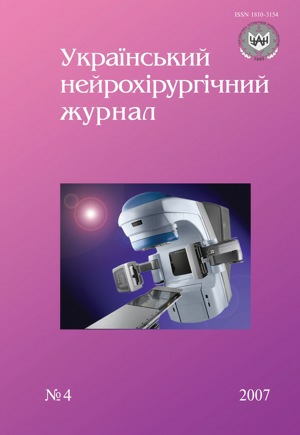The estimation of surgical treatment results at degenerative disease of thoracic spine
DOI:
https://doi.org/10.25305/unj.112328Keywords:
thoracic spine, hernias, scale.Abstract
In the period from 1990 to 2007 surgical treatment of thoracal spine hernias were lead at 58 patients. Some kinds of surgical approaches were used: standard back access with laminectomy — at 21 patients, transthoracic access — at 2, lateral extracavitar approach — at 5, transfaset pediculosaved approach — at 7, lateral transpedicular approach — at 23. Result, estimated according the scale, show patient’s with thoracal myeloradiculopathy condition: excellent result (75–100% according to scale) was matched at 9 patients, good result (50–74%) was obtained at 34 patients, satisfactory result (25–49%) was observed at 9 patients, the state of 4 patients remained without changes (0–24%), at 2 patients result were estimated as bad (less than 0%). Estimation scale application at patients with thoracic spine hernias (scale of thoracic myeloradiculopathy) allowed to objectivate surgical treatment results, and also to compare them with thoracic spine hernias treatment results, using different approaches.References
American Spinal Injury Association: Standards for neurological classification of spinal cord patients // Chicago: American Spinal Injury Association, 1992. — 80 p.
Baker C.D., Pynsent P.B., Fairbank J.C. The Oswestry Disability Index revisited: Its reliability, repeatability and validity, and a comparison with the St. Thomas’s Disability Index // Back Pain: New approaches to education and rehabilitation / Eds. M.O. Roland, J.R. Jenner. — Manchester: University Press, 1989. — P.174–186.
Fairbanks J. The Oswestry Disability Index // Spine. — 2000. — V.25, N2. — P.2940–2953.
Fairbanks J., Davies J., Couper J., O’Brien J. The Oswestry low-back pain disability questionnaire // Physiotherapy. — 1980. — V.66. — P.271.
Fisher C., Noonan V., Bishop P. et al. Outcome evaluation of the operative management of lumbar disc herniation causing sciatica // J. Neurosurg. Spine. — 2004. — V.100, N4. — P.317–324.
Hakkinen A., Ylinen J., Kautiainen H. et al. Does the outcome 2 months after lumbar disc surgery predict the outcome 12 months later? // Disabil. Rehabil. — 2003. — V.2, N25. — P.968–972.
Hawk P., Cheryl T. Update on the Research Network: Use of the SF-36 health survey (RAND-36) // Palmer J. Res. — 1995. — V.2, N2. — P.32–33.
Health Outcomes Institute. Low back pain type specifications. — Bloomington, MN: Health Outcomes Institute, 1992. — 57 p.
Hudson-Cook N., Tomes-Nicholson K., Breen A. The revised Oswestry low back pain questionnaire // Thesis, Anglo-European College of Chiropractic, 1988. — P.125–126.
Huskisson S. Measurement of pain // J. Rheumatol. — 1982. — V.9. — P.768.
Hutchinson P.J., Laing R.J., Waran V. et al. Assessing outcome in lumbar disc surgery using patient completed measures // Br. J. Neurosurg. — 2000. — V.14, N3. — P.195–199.
Izumida S., Inoue S. Assessment of treatment for low back pain // J. Jаp. Orthop. Assoc. — 1986. — V.60. — P.391–394.
Jensen M., Karoly P., Braver S. The measurement of clinical pain intensity: A comparison of six methods // Pain. — 1986. — V.27. — P.117.
Jensen M.P., Kаroly P., O’Riordan E.F. et al. The subjective experience of actual pain: an assessment of the utility of 10 indices // Clin. J. Pain. — 1989. — V.5. — P.153.
Lawlis G.F., Cuencas R., Selby D. The development of the Dallas Pain Questionnaire for illness behaviour // Spine. — 1989. — V.14. — P.511.
Downloads
Published
How to Cite
Issue
Section
License
Copyright (c) 2007 E. I. Slyhnko, A. M. Zolotoverсh

This work is licensed under a Creative Commons Attribution 4.0 International License.
Ukrainian Neurosurgical Journal abides by the CREATIVE COMMONS copyright rights and permissions for open access journals.
Authors, who are published in this Journal, agree to the following conditions:
1. The authors reserve the right to authorship of the work and pass the first publication right of this work to the Journal under the terms of Creative Commons Attribution License, which allows others to freely distribute the published research with the obligatory reference to the authors of the original work and the first publication of the work in this Journal.
2. The authors have the right to conclude separate supplement agreements that relate to non-exclusive work distribution in the form of which it has been published by the Journal (for example, to upload the work to the online storage of the Journal or publish it as part of a monograph), provided that the reference to the first publication of the work in this Journal is included.









